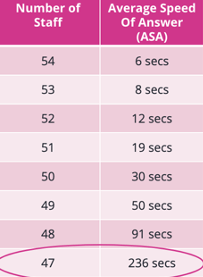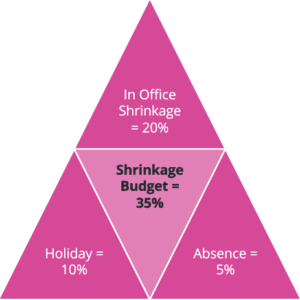Staffing utilization, colloquially known as “shrinkage”, takes an agent on payroll away from their job and into other forms of doing (or not doing). Utilization significantly affects overall call center KPIs and can easily and sneakily negatively impact call center results. Most call centers use this measure for planning and staffing purposes, to ensure calls are answered and CSAT kept high. However, shrinkage or staffing utilization is also a leading indicator of employee engagement and satisfaction and can be a major KPI to measure the success of such initiatives.
The link between utilization/shrinkage and employee disengagement
Many call center agents lack a sense of agency. They do the work but they don’t necessarily buy into the belief that their efforts have an impact they should care about. Remote or hybrid work isn’t making them feel any more connected to their work. But their success is closely tied to their thinking that their work matters.
Indeed, employee engagement is closely related to absenteeism and low productivity which lead to low utilization/shrinkage. Contact center managers know this and are always on the lookout for how to deal with absenteeism. A June 2022 survey by Centrical had 56% of respondents say that absenteeism is the number one metric they use to track employee engagement, more than ESAT or any other metric.

Without engagement, employees will be more likely to engage in this type of self-talk:
- “It’s Friday, I’ll call in sick. No one will notice!”
- “I hate Mondays, I’m not bothered if I’m late.”
- “It’s too busy, I’ll take an extra 5 minutes on my lunch break.”
These employees may not be aware of how they are impacting utilization/shrinkage and, as a result, overall service levels and other core KPIs. They also may not be aware of how their absence affects the m
orale of their peers due to increased workload and reduced bandwidth.
Here’s an example:
A call center has 100 agents, 700 calls coming in over 30 minutes, and an average handling time of about 237 seconds. If one agent is absent against the plan, it takes the service level from 83.4 percent down to 78 percent. If 5 people call in sick the service level drops to 43%!
Disengagement is more than shrinkage/low utilization
Disengaged employees do more harm than leaving or adversely affecting shrinkage.
They most probably will cause ACW to go up, through bad adherence or poor customer service. Call-avoiding behaviors may have a similar effect as well as unplanned absences, from emergency time off to employees going AWOL.
Similarly, absenteeism affects many core metrics relating to the contact center. It too influences CSAT, FCR, overtime costs, schedule adherence, penalties, and contact abandons.
What is low utilization/shrinkage?
Low utilization/shrinkage is about measuring anything that prevents agents from taking customer-related work (calls) despite their being at work, on payroll. There are additional definitions of the term, each taking a different point of view:
- Scheduled or unscheduled activities at the call center that are taking employees away from customer work
- The difference between the total number of staff that’s employed and staff available for undertaking the actual work with the customers.
Here’s an example:


How Microsoft and Webhelp addressed shrinkage/low utilization with employee engagement management
Thinking about shrinkage/low utilization through the employee engagement prism puts a real dollar value on the importance of getting employees to care about work and making them feel cared for. Employee engagement management is about providing employees with a clear and intuitive visual path to success while ensuring each and every employee senses that there is an authentic opportunity for them to succeed.
Using a gamified “fitness tracker for work” approach does just that and, unsurprisingly, affects absenteeism. Microsoft implemented gamified employee engagement and saw a 12% reduction in absenteeism. When surveyed, 79% of respondents strongly agreed with the statement “I feel empowered to perform better at work because of Centrical.”.
After implementing employee engagement and a gamified approach, Webhelp saw a 6% reduction in short-term absenteeism and a 10% higher CSAT (on average) in client surveys.
This approach to reducing shrinkage can have a significant impact. Centrical estimates that in a contact center of more than 10,000 agents, shrinkage reduction can translate into more efficient work worth more than $2.4 M annually.
Engage and motivate your frontline teams
Improve performance with an AI-powered digital coach
Deliver world class CX with dynamic, actionable quality evaluations
Boost performance with personalized, actionable goals
Nurture employee success with the power of AI
Listen and respond to your frontline, continuously
Drive productivity with performance-driven learning that sticks
Drive agent efficiency, deliver client results
Keep tech teams motivated and proficient on products and services while exceeding targets
Maintain compliance while building customer happiness and loyalty
Enlighten energy teams to boost engagement
Engage, develop, and retain your agents while driving better CX
Improve the employee experience for your reservations and service desk agents










 Madeleine Freind
Madeleine Freind
 Natalie Roth
Natalie Roth Linat Mart
Linat Mart












 Doron Neumann
Doron Neumann Gal Rimon
Gal Rimon Daphne Saragosti
Daphne Saragosti Ella Davidson
Ella Davidson Ariel Herman
Ariel Herman Ronen Botzer
Ronen Botzer